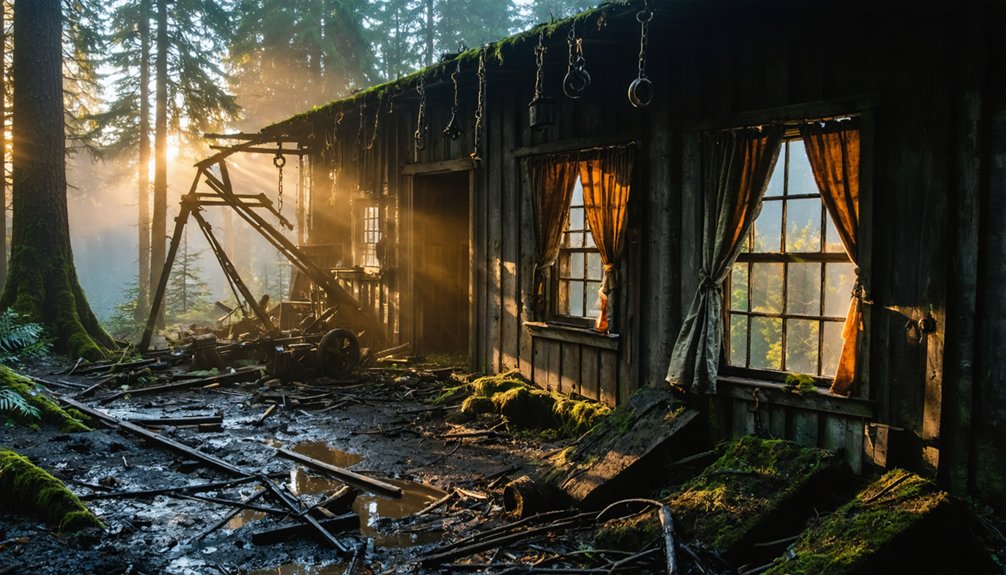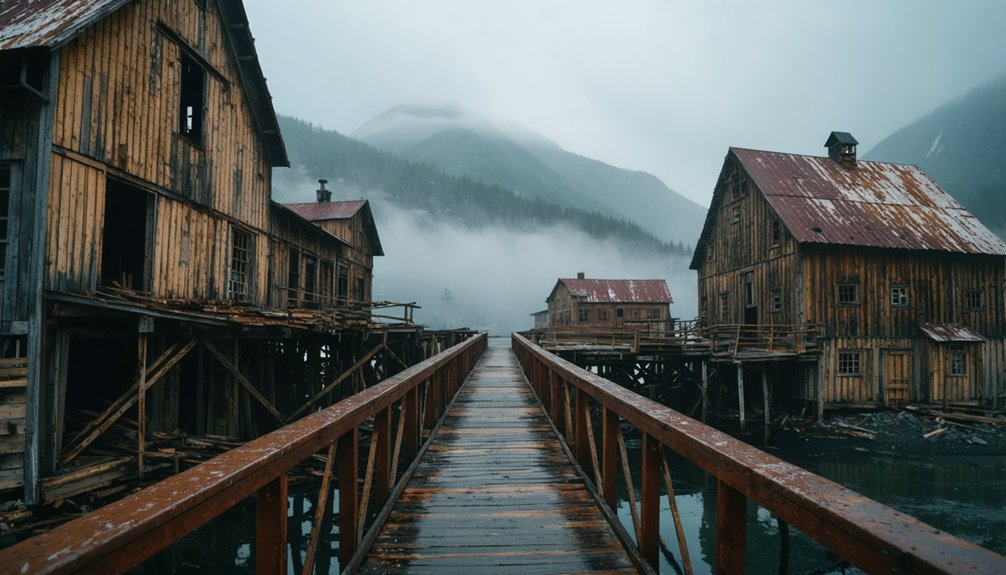Abandoned logging camps dot America’s forests as ghostly reminders of our timber-hungry past. You’ll find concrete foundations, rusty tools, and bunk frames slowly returning to the earth. These sites emerged during the 19th century westward expansion, where workers endured grueling “Hoot Owl” shifts for meager pay. Each moss-covered remnant tells a story of resource extraction and fleeting human presence. The forests reveal their secrets to those who know where to look.
Key Takeaways
- Abandoned logging camps reveal the remnants of America’s timber industry through concrete foundations, rusted machinery, and dilapidated structures reclaimed by nature.
- Logging towns like Teekalet (Port Gamble) flourished during 19th-century westward expansion but were often abandoned once local timber resources were depleted.
- Camp life featured harsh working conditions with minimal pay, communal cookhouses, sparse living quarters, and diverse communities despite segregation.
- Rich folklore traditions developed in these isolated communities, including tall tales, “lying contests,” and mythical creatures like the Hidebehind and Paul Bunyan.
- These sites represent both historical significance and intergenerational trauma, as logging identities shifted from authentic experience to nostalgic mythology.
The Rise and Fall of America’s Timber Towns
While the nation’s insatiable hunger for expansion carved its path westward through the 19th century, timber towns emerged as America’s ephemeral frontier outposts, sacrificial nodes in a resource extraction network that fundamentally altered the landscape.
You’ll find their origins in places like Teekalet (Port Gamble), established in 1853, where timber town dynamics revolved entirely around sawmills and the rhythms of extraction.
The logging industry evolution accelerated with the California Gold Rush and later steam power innovations, allowing penetration into previously untouchable forests. The invention of the Shay locomotive provided crucial traction and stability for transporting massive logs across uneven terrain.
As railroads pushed deeper into wilderness, company towns sprouted and flourished, only to wither when resources depleted. Life in these camps was particularly grueling, with loggers working long hours for minimal pay of about sixty-five cents for a ten-hour workday in the early 1900s.
Daily Life in the Shadow of the Sawmill
Beyond the mechanical roar of sawmills and the rhythmic chopping of axes, logging camps housed intricate social ecosystems where human lives intertwined with forest extraction.
You’d wake before dawn, especially during “Hoot Owl” shifts starting at 2 a.m., your daily routines dictated by the forest’s demands.
Women—”Dining Room Girls” or “flunkies”—rose by 5 a.m., baking dozens of pies and bread loaves that fueled the camp’s grueling labor. Women in the kitchen maintained strict dress codes, avoiding pants and tight clothing when serving the predominantly male workforce.
Before the lumberjacks stirred, women filled the camp with the aroma of fresh pies and hearty bread—nourishment for the day’s taxing work.
The cookhouse became the heart of camp camaraderie, where after exhausting shifts you’d gather for evening coffee and conversation.
Your sparse living quarters—simple cots and crates in utilitarian shacks—reflected the transient nature of this demanding work.
Yet within this harsh environment, you’d find moments of solace walking forest paths or sharing stories around wood stoves. Similar to Harrow’s End, these isolated communities often developed unusual practices that remained hidden from outsiders for decades.
Last Standing: Notable Camp Remnants Across the Nation
Across the forgotten corners of America’s wild landscapes, abandoned logging camps stand as silent monuments to an era when timber defined frontier economies.
From Michigan’s ghost town of Logan with its lonely cement foundation to Washington’s decaying railroad-based operations, these sites tell stories of resource extraction and human resilience.
You’ll find these historical treasures if you know where to look, their camp architecture slowly surrendering to nature’s reclamation:
- Village of Logan’s Methodist church foundations near Vanderbilt, now merely whispers in the forest
- White Mountains’ scattered camps with rusty logging tools along forgotten railroad grades
- Washington’s self-contained communities with deteriorating culverts and trestle ruins
- Pacific Northwest’s secretive operations, once hidden from public view, now revealed through time
The historical significance of these abandoned sites is now being documented by various historical societies, similar to the preservation efforts of the Otsego County Historical Society.
Explorers often discover the remnants of human habitation through the presence of bunk bed frames and scattered debris, providing tangible evidence of the workers who once populated these remote industrial settlements.
Forgotten Communities: The Human Stories Behind the Camps
The human dimension of America’s abandoned logging camps extends far beyond deteriorating structures and rusting equipment, revealing complex communities that once thrived in these remote wilderness outposts.
You’d find surprising cultural diversity as immigrants, African Americans, and others forged community resilience in these isolated environments, creating vibrant social networks despite harsh conditions.
Within these temporary settlements, where one-third of 18-year-old loggers wouldn’t survive to age 65, people established meaningful lives.
Workers earning just $26-30 monthly gathered in cookhouses to share stories and traditions, while women and children maintained makeshift schools and businesses.
Despite segregation and strict regimentation, distinct cultural expressions flourished.
The camps’ legacy persists in oral histories, reunions, and the emotional connections maintained by descendants who return to these forgotten forest communities.
One notable example is Grisdale in Washington state, which was the last camp in the continental United States to close in 1986.
Some sites, like the Cold Water Logging Trail camp discovered in 2023, have become associated with unexplained disappearances that contribute to their mysterious reputation.
Exploring Ghost Camps: What Remains in the Forest
When you walk through the dense forests that once housed bustling logging camps, you’ll find concrete foundations and collapsed wooden frames partially hidden by decades of natural reclamation.
Moss-covered machinery parts and rusted tools lie scattered among saplings that have taken root where lumberjacks once ate, slept, and worked.
These crumbling remnants tell a silent story of America’s resource extraction past, while the surrounding regrowth demonstrates nature’s persistent reclamation of human-altered landscapes. Many camps like North Pine Timber Company established strict daily routines under experienced foremen like Grant Harker, ensuring order in these isolated wilderness operations.
Hidden Foundations Reveal Past
Buried beneath decades of fallen leaves and forest regrowth, concrete slabs and foundation remnants tell silent stories of America’s logging past. As you wander these forgotten places, hidden structures emerge from the landscape—concrete chunks scattered across the forest floor and stone chimneys standing alone where bustling communities once thrived.
Foundation traces reveal how humans briefly claimed these wilderness spaces before nature reclaimed them. The forest now whispers through places where saws once screamed and boots once trampled. At Camp Disappointment on the Olympic Peninsula, the overwhelming vegetation has nearly consumed what remains, a testament to the challenging terrain that initially discouraged early explorers.
- Terraced hillsides cut into creek banks—scars of human intention slowly healing
- Solitary chimneys standing sentinel over vanished wooden homes
- Concrete markers sinking deeper each year into the embracing earth
- Stone foundations outlasting the temporary human presence they once supported
Nature Reclaims Human History
While foundations and chimney stones mark human engineering, time’s greatest architect—nature itself—conducts the most remarkable transformation of these forgotten logging camps.
You’ll witness dense forest growth progressively consuming what once hummed with industrial activity. Majestic Douglas firs now tower where thousands of their ancestors fell to the saw.
Nature methodically dismantles and recycles these historical artifacts. The canopy expands, concealing topographic markers that once defined these bustling communities.
Where children once played between neat rows of painted white houses, you’ll now find only scattered trash remnants and concrete pads slowly disappearing beneath moss and soil.
What makes these sites uniquely powerful is this tension between human endeavor and natural reclamation—the forest deliberately taking back what was momentarily borrowed from its domain.
The Cultural Legacy of Logging Camp Life
You’ll find the ghosts of robust cultural traditions in these abandoned camps where loggers crafted oral stories, songs, and superstitions that helped men cope with isolation and danger.
The “lobby-hog” storytellers and evening bunkhouse gatherings nurtured a distinct masculine identity tied to physical prowess, environmental knowledge, and shared hardship.
As traditional logging practices vanished with industrialization, these camps left behind not just physical remnants but the fading echoes of an occupational culture that once defined America’s relationship with its forests.
Camp Folklore Traditions
Deep in the shadow of towering pines, the cultural heartbeat of America’s logging camps pulsed through nightly storytelling sessions that shaped a unique wilderness folklore.
These tall tales weren’t merely entertainment—they embodied the spirit of the forest and those who wrestled resources from its grasp.
You would’ve found yourself drawn to these storytelling rituals after exhausting days of labor, where loggers transformed isolation into community through creative “lying contests” and cautionary fables about fearsome critters.
- The Hidebehind monster taught safety in pairs, making ecological danger comprehensible
- Paul Bunyan legends celebrated and questioned humanity’s relationship with ancient forests
- Camp cooks became mythic figures who sustained both bodies and spirits
- “Fearsome critters” represented the psychological wildness that remained untamed even as trees fell
- https://www.wfpa.org/news-resources/blog/americas-last-logging-camp-still-has-an-impact/
- https://www.youtube.com/watch?v=MUa9ME8E_NA
- https://www.dnr.state.mn.us/forestry/history/logging-camps.html
- https://digitalcommons.humboldt.edu/cgi/viewcontent.cgi?article=1037&context=etd
- https://npshistory.com/publications/voya/logging-era.pdf
- https://www.youtube.com/watch?v=8wBchDPS6Ig
- https://www.historylink.org/File/23147
- https://www.woodsplitterdirect.com/blogs/wsd/the-amazing-history-of-logging-in-the-united-states
- https://en.wikipedia.org/wiki/Logging_camp
- https://www.historylink.org/File/23208
Vanishing Logger Identity
As America’s virgin forests fell silent with the decline of industrial logging, the once-vibrant occupational identity of the logger began dissolving into cultural mythology rather than lived reality.
You’d recognize this cultural erosion in the transformation of logger identity from authentic experience into romanticized nostalgia. Where actual loggers found meaning through shared bunkhouse hardships and occupational hierarchies, their complex lives were flattened into Paul Bunyan caricatures that masked environmental destruction behind frontier heroism.
When timber conflicts erupted across the Pacific Northwest, entire communities faced existential crises as their occupational foundations crumbled. This identity displacement carried intergenerational trauma, particularly where logging had replaced indigenous relationships with the land.
Today, when you encounter abandoned camps, you’re witnessing more than empty buildings—you’re seeing the physical remnants of a vanished way of life.
Frequently Asked Questions
Why Were Women Rarely Present in Early Logging Camps?
Like trees in rigid formation, you’d find gender roles strictly upheld in camp dynamics, confining women to domestic spheres while deeming wilderness logging unsuitable for their presence and safety.
Did Logging Camps Follow Specific Architectural Designs or Layouts?
Yes, you’ll find logging camps followed purposeful camp layouts with utilitarian architectural styles—clusters of functional buildings that extracted resources efficiently while minimizing footprints on the forests they gradually consumed.
What Dangers Did Loggers Face Beyond Accidents and Disease?
You’d face devastating environmental impact through deadly weather and isolation, plus labor exploitation that crushed your spirit through cramped living, mental strain, and social stigma beyond the worksite.
How Were Holidays and Celebrations Observed in Isolated Camps?
Just as seasons transform the forest, camp traditions emerged through shared meals. You’d celebrate with rare pork chops and pies, gathering in makeshift community spaces where stories and homemade decorations replaced your distant seasonal festivities.
Were Logging Camps Segregated by Ethnicity or Nationality?
Yes, you’d find stark ethnic divisions in many logging camps, where labor dynamics carved social boundaries through the forest landscape, separating workers by race and national origin.



